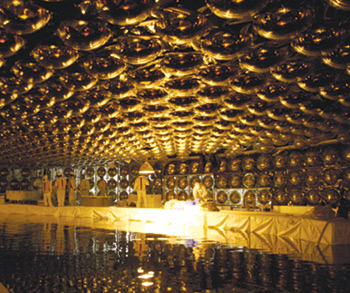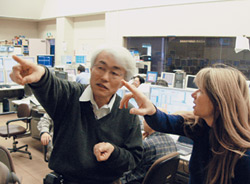Essay: Melissa Alexander
The beauty of Super-K
Recently I discovered that one of the most beautiful expressions of Japanese craftsmanship is neither a vase in a Tokyo museum nor a carving in a Kyoto temple. Instead, it rests deep inside a mountain in the Japanese Alps. Its beauty is a side effect of its design as its purpose is not intentionally aesthetic, although its intended targets are themselves arguably rather lovely. This giant, liquid extension of human vision, a Cherenkov detector in search of ubiquitous, elusive neutrinos, is like many finely made things the result of thousands of hours of human labor.
|
Super-Kamiokande is essentially a 13-million-gallon tank of ultra-pure water placed deep inside the remains of an old zinc mine. The tank is lined with golden-looking photomultipliers connected via cables to a massive computer nearby. The golden orbs are the largest ever made. Twenty inches in diameter, they are a demonstration of the artisanship that is still required to build such instruments. They are created using traditional glassblowing techniques, similar to what you could expect to find in an artist's studio. Their size is determined by the lung capacity and skill of the glassblower. As yet, no manufacturing process has been developed that can match the quality of these hand-blown tubes.
First completed in 1994, this technological Argus operated until it was blinded by a freak accident in November 2001. Now rapidly being rebuilt, it is scheduled to be complete this spring. I floated on a foam barge in the huge tank almost four years to the day of the accident. Next to me was Yoichiro Suzuki, the director of the experiment. The final installation was in full swing. A subset of the experimental collaborators from Japan, Spain, and the United States were busy replacing photomultipliers at a rate of 21 per day. We watched as workers in bunny suits climbed down into the tank from the vast cavern that is home of the experiment.
On November 12, 2001, a tiny but rapid change in pressure, most probably the result of a crack, occurred in a tube at the bottom of the tank. This caused the tube to implode, generating a chain reaction. In a matter of moments two thirds of the photomultipliers in the tank were destroyed. A new protective shielding now encases each tube to slow down any similar pressure wave enough for the glass to flex without breaking.
Equipment outside of the tank is swathed in plastic to protect against errant particles. Walkways are covered with sticky paper. You feel like you are in a giant clean room. But Super-Kamiokande's liquid and glass interior is gemlike. Reflections cast upon the blue water are iridescent, even elegant, and Suzuki reminds me a little of a modern Merlin floating in his human-made crystal cave. Banks of photomultipliers are being mounted on the tank's wall, six at a time, in a specially designed frame. When scientists are finished there will be 11,000 of these golden "eyes" peering into the water inside the 140-foot-high tank to witness the rare occasion when a neutrino collides with another particle and, in its demise, gives off evidence of its existence, to be recorded and analyzed.
|
I'm not a scientist. So neutrino detection is a lesson for me in perceiving scales of time and space as well as the human desire to know things. Neutrinos are so small yet require such vast efforts, geographies, and instruments to recognize them. That is beautiful enough. But neutrino detectors, whether fashioned out of vast sheets of Antarctic ice or from the interiors of cavernous mines and mountains, can also be considered beautiful in and of themselves if you are looking. I hope more people do.
Melissa Alexander
Melissa Alexander has chopped wood and carried water for the Exploratorium science museum in San Francisco for the past 17 years. She is currently a project director and develops online programs and Webcasts to support public understanding of science research.
Click here to download the pdf version of this article.




